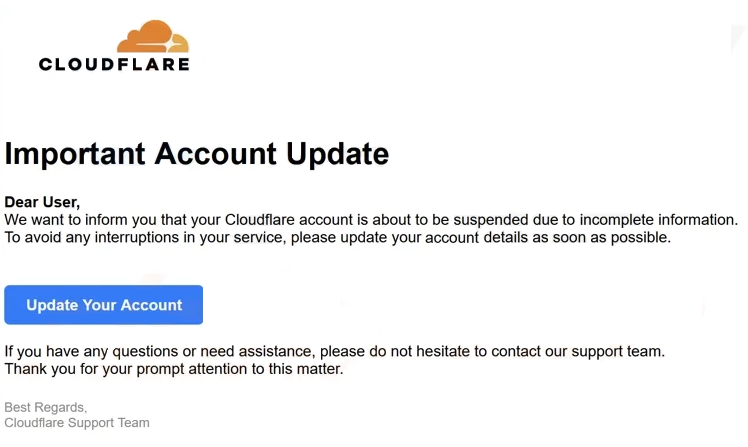The “Cloudflare – Important Account Update” email is a generic phishing email that aims to steal users’ Cloudflare login credentials. The email falsely informs users that their accounts are about to be suspended because information is missing. The email provides an “Update Your Account” button, which if clicked, will lead users to a phishing site. Users who type in their login credentials would likely lose access to their accounts.
The “Cloudflare – Important Account Update” email is a typical example of a phishing attempt. Threatening users with the deletion of their accounts is a common tactic used in many phishing campaigns, and it’s quite effective as well.
In this particular email, the sender claims that information is missing from your account. If you do not update the necessary information, your Cloudflare account will be suspended. To prevent this from happening, you are urged to click on the “Update Your Account” button.
The full text from the “Cloudflare – Important Account Update” email is below:
Subject: Urgent: Your Account Needs an Update..
Important Account Update
Dear User,
We want to inform you that your Cloudflare account is about to be suspended due to incomplete information.
To avoid any interruptions in your service, please update your account details as soon as possible.Update Your Account
If you have any questions or need assistance, please do not hesitate to contact our support team.
Thank you for your prompt attention to this matter.Best Regards,
Cloudflare Support Team
If you click on the button, you’ll be redirected to a fake login page where you’ll be prompted to enter your login credentials. If you submit your password, it will be sent to the cybercriminals behind this phishing campaign. The stolen credentials could then be used by the phishing campaign operators or they could be sold on a hacker forum for other cybercriminals to use. Whatever the case may be, the end result would be the same – you’d lose access to your account.
Accounts of services like Cloudflare are highly sought after by cybercriminals, so it’s crucial to protect your login credentials. To protect your accounts, it’s essential to learn how to recognize phishing emails and avoid divulging your personal information.
How to recognize phishing emails
Regular users are generally targeted by generic phishing emails, which are generally easy to spot. More sophisticated phishing campaigns are reserved for high-profile targets. Sophisticated phishing emails would not have any of the usual signs of a phishing email (e.g. grammar mistakes) and contain information that would give the email credibility. Fortunately for users, they are usually targeted with generic ones so they should be able to recognize when they’re about to be phished.
Phishing emails typically try to mimic legitimate companies. For instance, this “Cloudflare – Important Account Update” email is made to seem like it’s sent by Cloudflare. However, if you take the time to inspect it, it’s pretty clear that it’s a phishing email.
One way to assess the legitimacy of an email is to take into account how it addresses you. The “Cloudflare – Important Account Update” email uses a generic “Dear User” greeting rather than using your name. Legitimate emails from senders like Cloudflare always greet users by name or the name they provided to the service provider during registration. Words like “Customer,” “Member,” or “User” often indicate that the email is potentially harmful or at least spam.
Grammar and spelling mistakes are common signs of a phishing attempt. Legitimate companies rarely send emails with mistakes, particularly when it comes to automatic emails, as this would appear very unprofessional.
Phishing emails often claim there’s an issue with users’ accounts to prompt them to click on links and log in. This tactic is evident in this “Cloudflare – Important Account Update” email as well. For future reference, if you receive an email urging you to click on a link or open an attachment, do not interact with the email unless you are absolutely certain of its authenticity. If, for example, an email informs you about an issue in your account, access the account manually instead of clicking on any links. All unsolicited email attachments should also be scanned with an anti-virus program or VirusTotal to check for malware.
Finally, before logging into any site, always double-check that the URL is correct. While phishing websites can closely resemble legitimate ones, their URLs will always give it away. Malicious actors may employ various tactics to make their URLs seem credible, but with careful examination, you should be able to spot the differences easily.
“Cloudflare – Important Account Update” phishing email removal
If you receive this “Cloudflare – Important Account Update” email, you can safely delete it as it is a phishing attempt. If you have engaged with the email, clicked on the button, and entered your login credentials, you must change your account password immediately. If you are unable to access your account, please contact Cloudflare for assistance in recovering it.
Site Disclaimer
2-remove-virus.com is not sponsored, owned, affiliated, or linked to malware developers or distributors that are referenced in this article. The article does not promote or endorse any type of malware. We aim at providing useful information that will help computer users to detect and eliminate the unwanted malicious programs from their computers. This can be done manually by following the instructions presented in the article or automatically by implementing the suggested anti-malware tools.
The article is only meant to be used for educational purposes. If you follow the instructions given in the article, you agree to be contracted by the disclaimer. We do not guarantee that the artcile will present you with a solution that removes the malign threats completely. Malware changes constantly, which is why, in some cases, it may be difficult to clean the computer fully by using only the manual removal instructions.
